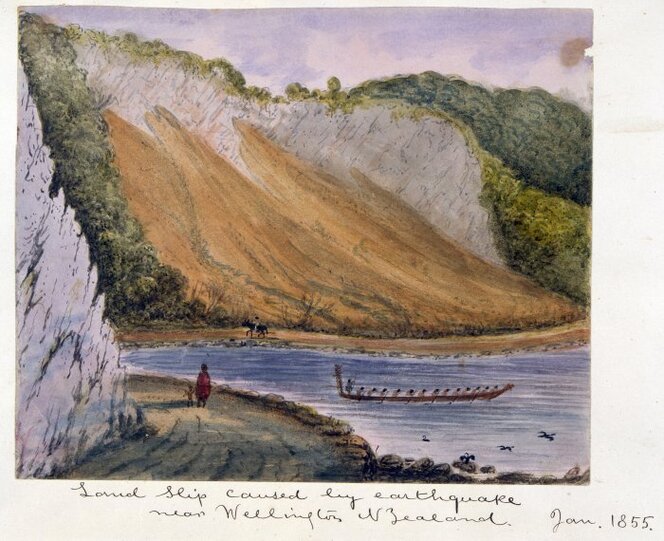Ngā Rū Whenua o Te Whanganui a Tara Earthquakes in Wellington

Other heritage topics
In 1855, an earthquake struck the Wellington Region, permanently altering its landscape. Measuring 8.2, it was New Zealand's most powerful earthquake and was caused by movement on the Wairarapa Fault:
On Tuesday 23rd of January 1855, as the sky slowly darkened to twilight at the end of a summer's day, Wellington was preparing to go to bed.
In a small 4-roomed house in Te Aro, the Darcy family sat playing dominoes by oil lamp. At 9.15 pm, without warning, the house began to move like 'waves on a sea'.
The family were thrown to the floor and the chimney crashed through the roof, covering everything with bricks and dust. Pictures leaped from walls, tables overturned and their upright piano came down with a crash.
In the Hutt Valley, Arthur Ludlam reported that the first shock lifted his house clean off the ground and shook it from side to side before it came crashing down. On Lambton Quay, Baron von Alzdolf was killed when his house of brick, one of the very few brick structures in Wellington, collapsed in on him. Wellington had just been struck by the most devastating earthquake since human occupation began.
Though the 1855 earthquake was the most dramatic earthquake ever recorded in Wellington, many larger (and smaller) quakes have had a role in shaping our geography, our building practices, the lay-out of our city, and our social history. They have even led to the creation of urban myths - such as how until 1855, ships used to sail up what is now Kent and Cambridge Terrace, to dock at what is today the Basin Reserve. (a canal to the Basin Reserve was once planned but was never built!)
Wellington is prone to earthquakes because it rests on the point where two tectonic plates meet. Kilometres beneath Wellington the light, thick Australian plate rides over the heavier, but thinner Pacific plate. These plate movements have resulted in three major fault-lines running either through or very close to Wellington City - the Ohariu Fault, the Wairarapa Fault, and the Wellington Fault. It is when one of these faults shifts suddenly that earthquakes occur. The number of earthquakes which occur in Wellington has led to our city becoming one of the world's leading centres for the study and research of earthquake activity and for the development of seismic strengthening techniques in buildings.

